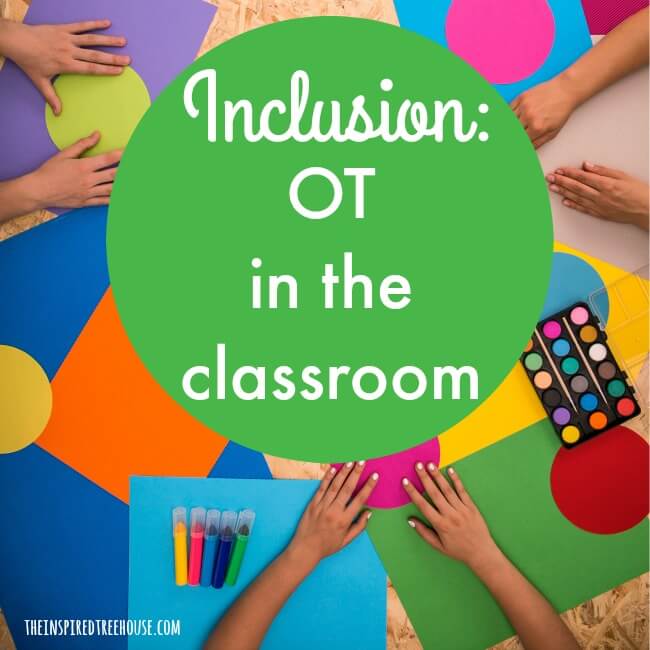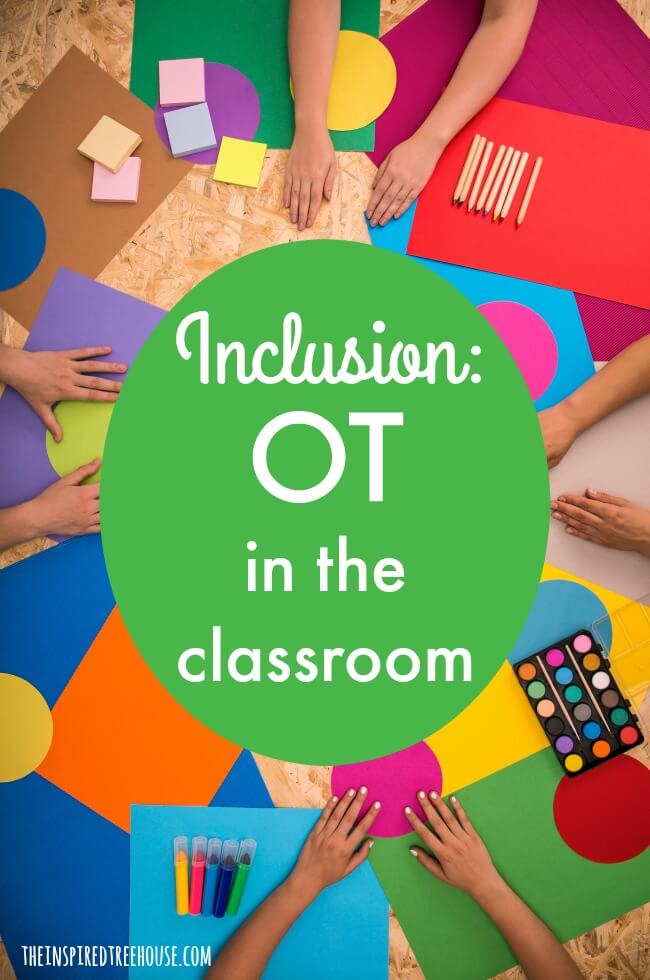From a therapy standpoint, inclusion means “pushing into” classrooms to deliver services rather than pulling kids out for therapy sessions.
One thing I’ve learned about inclusion during my years as a school based occupational therapist…it can be tricky. Another thing I’ve learned? It’s totally worth it.
*This post contains affiliate links. Read more.
I grew up with a sibling with significant special needs what I remember most about her experience in school was her desperation to fit in, to be accepted, to be treated with respect, and to be given the same opportunities as her peers.
When all of the pieces fall into place – inclusive support services can be an awesome way to help children with special needs grow and thrive. After all, the classroom is where they’re actually putting all of those fine motor, visual motor, cognitive, self care, and social skills to use – it’s the stuff occupational therapists’ dreams are made of!
Why Inclusion?
In many (if not most) cases, providing inclusive therapy services is simply best practice. Why?
1 || It provides kids with greater opportunities to generalize and apply skills in a natural setting.
2 || It provides therapists with better opportunities to consult and collaborate with classroom staff.
3 || Therapists gain a better understanding of how their services support actual participation and independence in the educational setting.
4 || Gives therapists a chance to model and demonstrate the use of techniques and strategies with students so they can be applied later, even when the therapist is not in the room.
5 || Children don’t feel singled out or “different” when services are provided in their classroom.
6 || Other students who may need extra support can benefit from the therapist’s presence in the classroom.
7 || There is less disruption of students’ schedules and routines when they are not being removed from class.
8 || Therapists can use peers as models and supports for new behaviors or skills.
Challenges to Providing Inclusion Services
But…like I said, providing services in the classroom can be tricky. School therapists typically have BIG caseloads and we often have to address issues on the fly (bathroom, behavior, etc.). This means lots of scheduling and rescheduling (and rescheduling again) and sometimes difficulty with maintaining consistent treatment times, which can be hard when you’re trying to be in a classroom on a consistent day and time.
Being able to work within a classroom also means establishing a great rapport and relationship with the teacher and the students. It takes confidence, sometimes a little assertiveness, and also a willingness to work with the classroom staff and kids to figure out how you can add to what’s happening in the classroom rather than becoming a distraction or disruption.
Ideas for Inclusion OT Services
So, what are the best ways to provide therapy services in an inclusion setting? Admittedly, this is an area that I’m always working on in my practice. I have great stretches where I’m able to be in the classroom more often, and then when things get busy, treating kids in the classroom seems to be the first thing to go. But every single school year, I make it my goal to increase the amount of time I spend in my students’ classrooms.
Here are some of my favorite ideas for providing inclusion therapy services:
1 || Demonstrate activities and leave them behind.
I schedule a time to go into the classroom to demonstrate exercises for kids or other activities that could be used as movement breaks for the entire class as part of the daily routine. Then, I’ll leave a list of the activities for the teacher to use later. Chances are, there are many students in the classroom who can benefit from these!
2 || Recess is your friend!
This works in a couple of ways…Here in Ohio, we have cold, rainy, snowy weather for a good chunk of the school year, which often means indoor recess. There’s nothing kids love more than a fresh face showing up with a new toy or game that they can play with a group of their friends during recess (and, they’ll be working on important developmental skills in a fun way!). Check out these creative indoor recess games and activities!
You can also go for it out on the playground! Grab some outdoor toys and head into the sunshine! Try some of these activities with sidewalk chalk, hula hoops, or bubbles!

3 || Show up for handwriting time.
Working on handwriting? Sometimes I’ll ask the teacher if there is a regular time during the day or week when the class works on a handwriting book, journals, or free writing activities. Then, I make this my therapy time! Offer to sit with a group of students who are all struggling with handwriting (even the ones not on your caseload) to provide support – most teachers are happy to have extra help, especially help from someone who is trained in providing visual motor and fine motor interventions!
4 || Use centers for therapy activities.
Teachers often use a “centers” format where students break into small groups to work on different activities around the classroom. This is the perfect time to make your way into the classroom. Bring your own fine motor, core strength, visual motor, or other activity into the classroom and facilitate one of the “centers” yourself.
Then, leave the materials for your “center” in the classroom for the teacher to use for the rest of the week so kids are still working on necessary skills even when you’re not there! Bonus points! Rotate your “center” out each week and you’ll likely have a very happy teacher on your hands who has one less thing to plan!
5 || Plan your own lesson.
This is one of my favorite ways to get to know a classroom and to show a teacher what I’m all about. I set up a time with the teacher where I can facilitate a 30 minute lesson in the classroom with all of the children. Most often these lessons are co-treatments with my speech therapy and physical therapy friends!
We put together a themed language/sensory motor lesson plan and have seen awesome results from being in the classroom and getting all of the kids in on the therapy action! Plus, it gives teachers a little break if they need to make copies, grade papers, or run to the bathroom…which we all know is a luxury to someone who has to be “on” and up in front of kids all day long!
6 || Fill the sensory table!
This is one of my favorite ways to get into my preschool classrooms. I ask the teacher if she would like me to plan out some ideas for things to go in her sensory table – it could be a tactile sensory activity that goes along with the season or classroom theme, or it might be a fun fine motor activity with manipulatives. I’ll sit in the classroom and facilitate play at the table for direct service and then leave the contents in the table for a week or two before changing it out. Again, one less thing for the teacher to plan and one more fun way to get therapy into the classroom!
7 || Show up for arrival and departure routines.
Be present in the classroom for the arrival and departure routines. There’s no better time to see fine motor, cognitive, and self care skills in living color than when kids first get off the bus in the morning and when they’re packing up at the end of the day.
You can provide all kinds of supports (visual schedules, checklists), adaptations, and interventions during this time for dressing skills, clothing fasteners, transitions and more! And teachers will love you for being there to help at the most chaotic times of day!
8 || Try seeing kids for therapy during art, music, physical education, or library.
So many great opportunities for therapy here! I’ve requested copies of songs from the music teacher to make visual picture prompts for kids to be able to follow along more easily in music class. I’ve joined in on art classes to work with kids on fine motor and visual motor skills – this is also a great chance to support kids who are hypersensitive to tactile input (lots of messy activities in art class!).
9 || Go to lunch!
Lunchtime is another great time to provide inclusive therapy services. It’s a great way to work on functional fine motor skills as kids learn how to open food packages and use utensils to feed themselves and also the place to be if you want to work with kids who are picky eaters due to sensory processing concerns.
So what are your best tips for providing inclusion therapy services? We’d love to hear them! Share in the comments below or leave us a post on our Facebook page!

Latest posts by Claire Heffron (see all)
- Cute Zipper Bags for Therapists - April 18, 2024
- Fairy Tale Games and Toys - April 12, 2024
- The Best Emotional Regulation Books for Kids - April 8, 2024



[…] Today, we’re going to delve into a teacher-friendly, kid-friendly, and therapist-friendly approach to introducing fidgets and sensory materials into a classroom setting. If you’re a therapist, this would be an amazing multi-step, inclusion-based therapy plan. […]